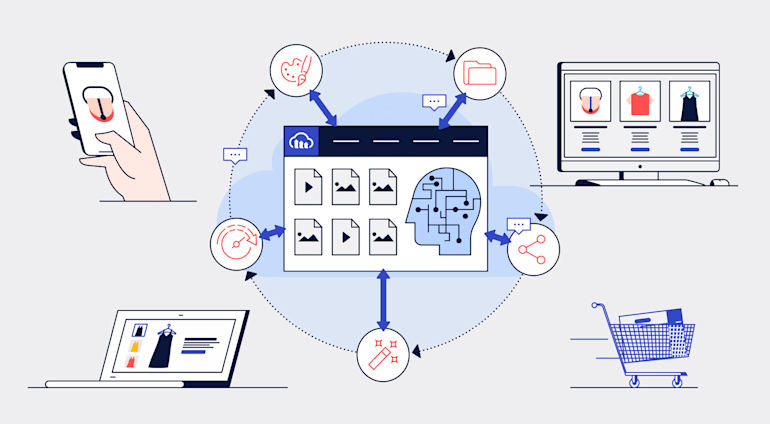E-commerce thrives as an attention-oriented economy in which customers expect engaging and high-quality experiences at all touchpoints. Given the increasingly prominent role images and videos play in customer experiences, e-businesses must focus on creating, managing, optimizing, and then delivering visual media in the most compelling and context-relevant way possible.
However, adopting a media-first strategy leads to complex workflows, in which various teams must each create assets of various types and in different formats for delivery across platforms. Absent vigilant coordination and efficiency, that workflow would not scale well, potentially leading to massive growing pains and frustrations for you and your customers alike.
The benefits of high-functioning workflows abound:
- Reduction of time to market
- Enhancement and optimization of the customer experience
- Elimination of bottlenecks through unburdening creatives, marketers, and other nontechnical teams of technical tasks.
- Enablement of flexible, agile, and responsive campaigns
That was the theme of the digital asset management (DAM) workshop Life of an Asset Liat Perlmutter and I led at Cloudinary’s virtual ImageCon 2020 conference. We suggested ways in which e-businesses can optimize complex media-related workflows, add product content to their websites and other channels that they own, and distribute optimal media assets to stakeholders. The solution lies in leveraging an open, API-rich DAM that automates most of the tedious and time-consuming tasks in media management with AI.
Subsequently, teams can focus on value-driving decisions and activities, such as developing the brand, looking for better ways to engage with customers, and aligning campaigns with broader business goals.
Below is the video of the full session.
Read on for a quick recap of the life cycle of a media asset, as addressed in our session.
The Problem: Managing Assets Requires a Team Effort
In today's agile publishing world, assets move back and forth among creative, marketing, development, and other internal and external stakeholders before being served to the public. Those diverse teams are responsible for—
- Creating assets
- Organizing assets in folders and subfolders
- Sharing assets with stakeholders whose levels of access and editing privileges vary
- Manipulating and customizing assets for campaigns through resizing, cropping, addition of overlays on top of images and videos, and other techniques
- Optimizing assets and delivering them responsively through a high-performance experience to customers worldwide
Even in organizations that store media assets in a central DAM system, teams often check them out when creating variants for campaigns. For example, an internal or external teammate might pull an image, edit it in another system, and publish it on a website or mobile app through yet another system. The constant handoffs and rotation of assets among teams and platforms invariably lengthens time to market and hurts customer experience.
Bottom line: The process of managing the life cycle of innumerable assets is largely unwieldy, cumbersome, and unsustainable.
The Solution: A Single Source of Truth
In reality, media-asset management is constant work in progress. A proven solution for enhancing the process is to maintain—for all assets—a universal single source of truth, whose value extends well beyond management tasks: storage, search, and so forth. That single source applies to all the phases in the life cycle, from creation to consumption for all branded, partner-originated, or user-generated assets: still images, videos, 360-degree spin sets, 3D images, 4K videos with zooming features.
Capabilities of Open, AI-Driven DAM Platforms
Open DAM platforms enable teams to collaborate—solicit feedback, edit, share—throughout the asset life cycle on a single-source basis. Talk about transparency, efficiency, and peace of mind!
Furthermore, robust and open DAM platforms automate the following tasks with AI:
- Tag all the content, images, and videos that have been uploaded to the platform to make them more searchable and usable.
- Create variants for all media assets in real time for deployment on social media, mobile, even offline channels like print, leveraging comments and notifications to facilitate collaboration among stakeholders during the creation phase.
- Personalize assets in real time through intelligent identification of subjects, removal of background and location, delivery of shopper-based content, and addition of text overlays.
- Deliver engaging experiences to all channels: web, mobile, and social.
- Manage access permissions for both internal and external stakeholders.
- Optimize performance by displaying the highest-quality content that a given platform can manage without impacting loading speed.
A Step-By-Step Lesson on Workflow Optimization Through DAM
Our workshop’s recording contains a step-by-step and nontechnical overview of how an integrated and intelligent DAM streamlines the life cycle of media assets and enhances organization efficiency and customer relationships. Do have a listen.
In particular, through an example of a product launch, the workshop shows you how to do the following:
- Support media assets’ life cycle.
- Publish the optimal version of images and videos in all contexts through auto-tagging, intelligent search, automated preset-based delivery, optimization, and so forth.
Visual media offers a huge opportunity for organizations to productively engage with audiences in depth. So, be sure to scale visual-heavy campaigns by efficiently managing media, from creation to delivery, without exception. The importance of doing that and the opportunities that will arise as a result are hard to overstate. View this workshop and more at Cloudinary.com/imagecon.





